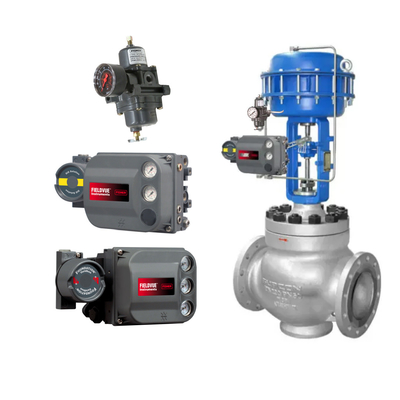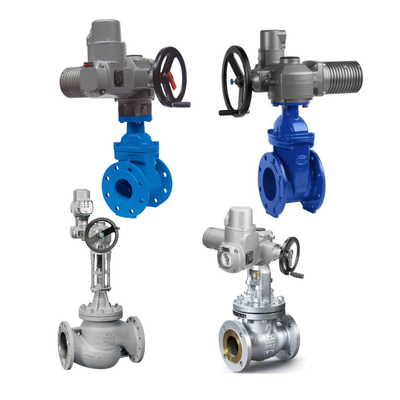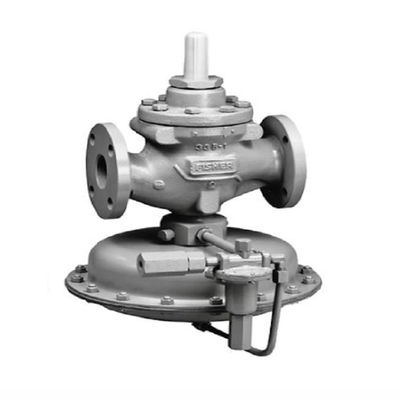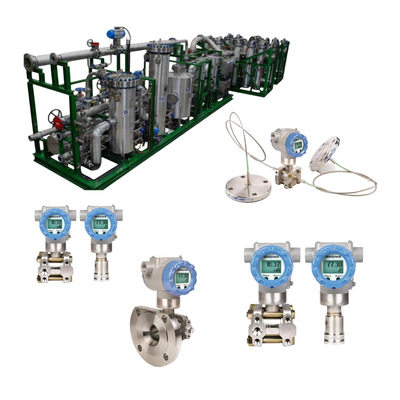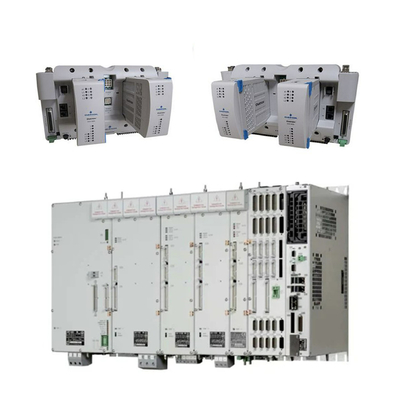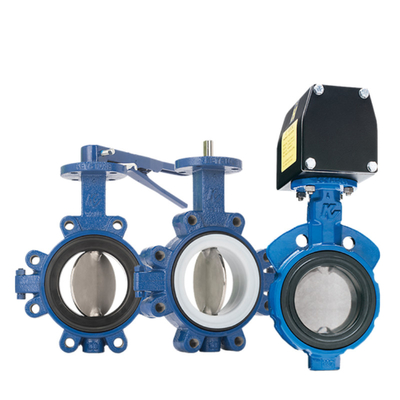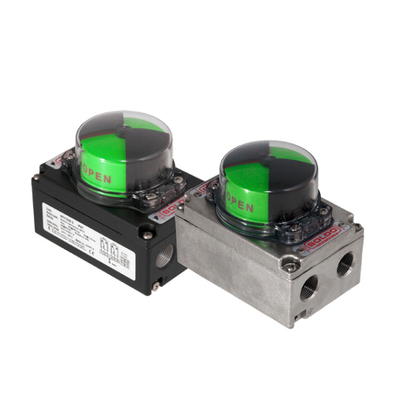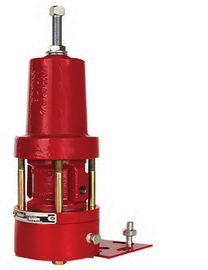The following are some common pneumatic control valve accessories and their functions and working principles:
Valve positioner

Role:
used in conjunction with pneumatic actuators to improve the positional accuracy of the valve, to overcome the friction of the valve stem and the effect of media imbalance, to ensure that the valve is correctly positioned according to the regulator signals; can also be achieved by the gas-open and gas-closed mutual conversion, change the flow characteristics of the valve and so on.
Working principle:
Take the principle of torque balance as an example, when the signal pressure into the bellows increases, the main lever rotates around the pivot point, making the nozzle baffle close to the nozzle, and the back pressure of the nozzle is amplified and passed into the actuator membrane chamber, the valve stem moves downward, and at the same time, it drives the feedback lever and the feedback cam to rotate, and stretches the feedback spring, and the actuator position is maintained at a certain degree of openness when the tension of the spring and the pressure of the signal reach a torque balance on the bellows. When the spring tension and the signal pressure reach the torque balance on the bellows, the valve position of the actuator is maintained at a certain opening degree.
Gas storage tanks:
Role
- Stabilize air pressure: balance the pressure fluctuation of the compressed air supplied by the compressor, prevent the rapid decompression of compressed air when it is used in large quantities instantly, and ensure that the air-using equipment is supplied with stable air pressure 1.
- Protect the equipment: reduce the number of frequent starts of the air compressor, extend the service life of the air compressor. Because the storage tank can store a certain amount of compressed air, when the air-using equipment consumes less air, the air compressor does not need to run continuously 1.
- Reserve emergency air source: In case of emergency such as failure of air compressor or power failure, it can provide temporary compressed air for pneumatic equipment to avoid equipment failure or safety accident due to sudden loss of air 1.
- Separation of impurities: when compressed air stays in the storage tank, it can make the impurities such as water, oil and solid particles in it precipitate, initially purify the compressed air, improve the air quality, and reduce the burden of the subsequent filters and dryers .
Classification
- According to the pressure points:
- High-pressure tanks: withstand high pressure, used to store high-pressure gases, usually more than 10MPa pressure.
- Low-pressure gas storage tanks: relatively low pressure, generally used for occasions that do not require high pressure, the pressure is usually between 0.1MPa and 1MPa.
- Atmospheric pressure storage tanks: the working pressure is close to atmospheric pressure, mainly used for storing some atmospheric pressure gases or as buffer containers.
Pneumatic triplex

Role:
including air filter, pressure reducing valve and oil mist. The air filter filters the impurities and moisture in the compressed air to protect the pneumatic components; pressure reducing valve will reduce the inlet pressure to the required outlet pressure, and keep the outlet pressure stable, to provide standard power for the pneumatic control valve air pressure; oil mist can be lubricated on the air to reduce wear and tear of pneumatic components.
Working principle:
air filter through the filter element and other filtering materials to block impurities; pressure reducing valve through the adjustment of the spring, spool and other parts of the coordination, according to the set pressure value to automatically adjust the outlet pressure; oil mist is the use of airflow will be atomized lubricating oil mixed into the airflow.
Solenoid valve

Function:
When the system needs to realize the program control or two-position control, through the excitation / demagnetization control pneumatic control valve airway on and off, so as to realize the opening and closing of the valve.
Working principle:
for two three-way solenoid valve, the coil is energized, the spool moving, so that the inlet and outlet holes connected to the exhaust holes closed, the gas source into the actuator to drive the valve action; coil de-energized, the spool reset, the gas circuit to restore the initial state. Two five-way solenoid valve has two air outlet holes and two exhaust holes, can realize the positive and negative action control of the actuator.
Pneumatic Relay
Function:
As a kind of power amplifier, it can transmit the pneumatic signal to a faraway place and eliminate the lag brought by the lengthening of signal pipeline; it can also amplify or reduce the signal.
Working Principle:
By changing the size and pressure of the air chamber to control the size of the output air pressure signal and on and off, so as to realize the signal amplification, reduction and long-distance transmission and other functions.
Electro-pneumatic transducer

Role:
Electro-pneumatic transducer converts pneumatic signals into electrical signals, and electro-pneumatic transducer converts electrical signals into pneumatic signals, which is mainly used to realize the mutual conversion between pneumatic and electrical signals, so that pneumatic actuators can be used in the systems controlled by different signals.
Principle of operation:
the use of sensitive components to convert changes in air pressure or electrical signals into changes in mechanical displacement or force, and then through the conversion element will be converted to the corresponding electrical or pneumatic signals.
Self-locking valve

Function:
When a gas source failure occurs, it can cut off the gas source signal, so that the pressure signal of the membrane chamber or cylinder is kept in the state of the instant before the failure, and maintain the valve position unchanged, and play the role of position-holding.
Working principle:
during normal operation, the pressure of the gas source keeps the self-locking valve open, when the pressure of the gas source fails to drop, the spool in the self-locking valve closes quickly under the action of the spring force or other mechanical force to prevent the leakage of the gas in the membrane chamber or cylinder, thus maintaining the valve position.
Valve position transmitter

Role:
When the control valve is far away from the control room, the valve opening mechanism displacement will be converted into electrical signals sent to the control room according to a certain law, so that the operator can accurately understand the position of the valve switch without the scene.
Working Principle:
Usually using potentiometers, encoders and other components, the mechanical displacement of the valve stem is converted into electrical signals, such as through the potentiometer will be converted into a change in the resistance value of the valve stem, and then converted into the corresponding voltage or current signal transmission to the control room.
Limit switch

Role:
reflecting the valve switch two extreme positions, and at the same time send an indication signal, the control room can be based on this to determine the switching state of the valve in order to take appropriate measures.
Working Principle:
When the valve reaches the fully open or fully closed position, the valve stem or other mechanical parts touch the contact of the travel switch, so that the contact is closed or disconnected, thus changing the on-off state of the circuit and generating the corresponding switching signal.
Manual operating lever

Role:
In case of emergency or need for manual adjustment, the valve can be operated directly by the manual operating rod to open and close, convenient for maintenance and emergency treatment.
Working Principle:
The manual operating lever is connected with the valve stem or other transmission parts, and the valve stem is driven to move by manpower rotation of the operating lever, so as to realize the opening and closing of the valve.

 Your message must be between 20-3,000 characters!
Your message must be between 20-3,000 characters! Please check your E-mail!
Please check your E-mail!  Your message must be between 20-3,000 characters!
Your message must be between 20-3,000 characters! Please check your E-mail!
Please check your E-mail! 
